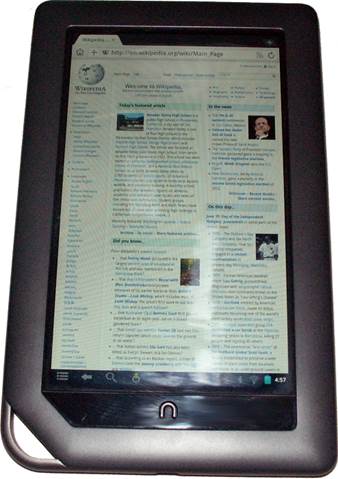Browser
Barnes & Noble provides a relatively
easy-to use browser – this is what you may find in such a basic tablet like
this. At the top, you have different tabs that can be added by clicking on the
+ sign. Below this, you will see the navigation bar and buttons, and 1
bookmarks symbol which brings you a browser thumbnails on a plain background. Along
the bottom, there are icons for sharing (via email and Evernote), searching and
ActiveView, which tie with the reading focus of the device by offering stories
on the website in a magazine-like format. A new bookmark for the current page
can be created by clicking on the top right corner and it will help you
accessing to deeper reading settings.

Barnes
& Noble provides a relatively easy-to use browser
Reading
Reading is still the main purpose of the
Nook series, at some level, like the previous Nook Color, the HD can be
considered as the reader with some additional tricks. After all, it is obvious
that the company designed the form factor around the reading experience. Based
on that, in press materials for the company, reading is usually mentioned
before any of other things like movies and apps, regardless of the more
high-definition screen. There are not many things that have been changed in the
prose-reading. You have a page which is mainly dominated by text, except for
the title at the top and your progress at the bottom. You can also turn pages
by a standard swipe, although by teasing with settings, you might find out a curl
animation that imitates the real page of the book.

Nook
HD’s reading animation
Clicking at the progress at the bottom, you
will have a slider which allows flipping through the book. You can also see the
information of the book (cover, evaluation, introduction), searching for key
words and sentences, sharing as well as format adjustments – which offers 8
different text sizes, 6 different font sizes and 6 page colors, along with many
other things.
More visual text is where Nook HD really
has the competitive advantage. Magazine like Details really looks impressive on
the HD’s screen. While Nook HD+ provides better form factor for such kind of
reading, you can quickly get familiar with the text. In order to have a more
easy-to-understand experience, Barnes & Noble is offering ArticleView which
is just the same as what you get on the browser. The images will disappear
whenever you click on it, and then a similar layout as the printer-friendly
format is provided by many news websites.
Tap at the bottom of the screen, you will
get a carousel of newspaper pages. Below this are links to grid-shape layout
which offers the book entirely and is displayed like thumbnails on one single
page. The content can also be displayed via a more traditional TOC. The
excellent transmission animations make the whole experience perfectly
interesting, creating a smooth stream of reading experience. For incomplete
feeling that you might have when navigating to UI, it is clear that B&N
invested a fortune in improving magazine reading this time.
The comics also turn out to be so
interesting to read on Nook HD. The colors are really lively and the act of
activating ZoomView Letterboxing support the panel by panel reading, which is
really an ideal solution for enjoying the continuous images on tablet. Just
like in the magazine, you can also see a carousel at the bottom of the page,
together with text and images of the content.

Special
feature for children’s book reading
Barnes and Noble also added some shopping
categories into the customized reading list. The options look really alike that
of the magazine, what is different is that they are free as the only role that
it plays is to sell the products to you. Pictures are accompanied by hotspots
which link you to the product pages where you can purchase for that product
whenever you click on them. They absolutely looks wonderful, but in the world
where catalogs are considered as trash for most of the users, it is so hard to
imagine the feature which serves as the main selling channel for many of the
users.
Meanwhile, children’s books have always
been the secret weapons of Barnes & Noble’s products. The company has
tightly cooperated with the producers to provide a really considerable
experience to exploit the potential of devices’ multimedia, by adding the audio
effects, animations and music. Opening the books will give you three different
experiences: Read By Myself, not offering the narration, Read and Play,
providing the built-in narration and Read and Record, allowing parents to
record their narrations for the children.
Like other texts, there is always a
carousel at the bottom of the screen. All of these things, together with the
affordable cost, durable design, a small form factor and user profiles create
an eloquent argument for Nook HD in proving its role of a strongly desired
device of families. All of the process is very simple, and once the profile has
been created, it is synched with other Nook devices with the same account.